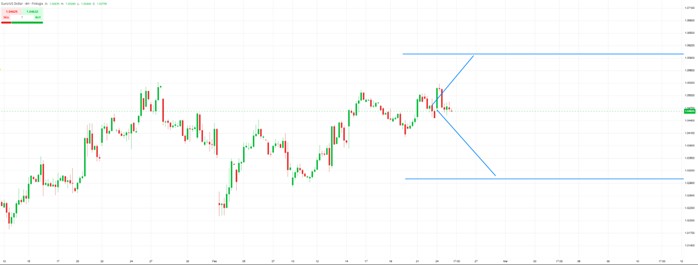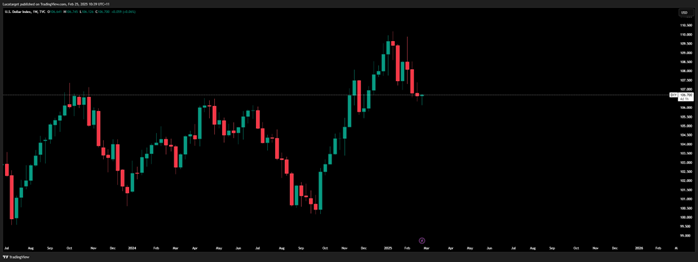
EUR Strengthens Amid German Political Stability, USD Faces Uncertainty
 ACY Securities - Luca Santos
ACY Securities - Luca Santos
The euro (EUR) has emerged as the strongest-performing G10 currency following the recent German election results, where the center-right CDU-CSU secured victory with 28.5% of the vote. Financial markets reacted positively, largely because the far-right Alternative for Germany (AfD) did not surpass expectations, garnering 20.8% rather than significantly outperforming recent polling estimates. This outcome provides a sense of political stability, which has supported the euro's recent strength.
EURUSD H4

The election results also indicate a likely coalition between the CDU-CSU and the Social Democratic Party (SPD), with a combined estimate of 328 seats in the 630-seat parliament. The absence of the left-wing BSW party in parliament would simplify coalition negotiations, potentially leading to swift policy implementations. Investors are now focusing on the possibility of fiscal policy adjustments, including a suspension or revision of Germany’s stringent debt brake to enable increased public spending, particularly in defence. While a complete overhaul would require a two-thirds majority, a temporary suspension due to geopolitical concerns—such as the war in Ukraine—remains a possibility.
From a macroeconomic perspective, Germany’s economy continues to face challenges, with elevated economic policy uncertainty. However, the formation of a stable government could lead to pro-business policies under Friedrich Merz’s leadership, potentially improving growth prospects for 2026 and beyond. Consequently, some analysts maintain an optimistic year-end EUR/USD target of 1.0800, contingent on a smooth coalition process and supportive fiscal measures.
In contrast, the U.S. dollar (USD) has experienced its third consecutive week of declines, reversing over 3% of its gains since Donald Trump’s election victory. Investor sentiment suggests growing optimism that Trump’s trade policies may not be as disruptive as initially feared. However, ongoing trade policy uncertainty continues to weigh on the dollar’s performance. Markets are monitoring Trump's proposed tariff hikes, including planned increases on steel, aluminium, automobiles, semiconductors, and pharmaceuticals, which could elevate volatility in the FX markets.
USD Index Weekly Chart

Additionally, softer-than-expected U.S. economic data has contributed to the recent dollar weakness. Key economic indicators—including the housing market index, housing starts, services PMI, and consumer sentiment—have all shown signs of softening. The Atlanta Fed’s GDP growth tracker for Q1 has now declined to 2.3%, suggesting that the economic slowdown observed at the end of last year has persisted into 2025. Notably, consumer sentiment surveys indicate heightened concerns over inflation, particularly regarding the potential impact of Trump's trade policies.
Looking ahead, the USD’s trajectory will be shaped by upcoming trade developments and economic data releases. If Trump moves forward with aggressive tariff hikes, a resurgence in market volatility could support the dollar in Q2. Conversely, should the administration soften its trade stance or secure trade agreements, the USD may face further downside pressure.
Overall, while the euro’s near-term strength is driven by political clarity in Germany, the dollar’s outlook remains uncertain amid trade policy risks and economic softness. Market participants will continue to assess fiscal policy shifts in Europe and trade negotiations in the U.S. to gauge the next moves in EUR/USD.
This content may have been written by a third party. ACY makes no representation or warranty and assumes no liability as to the accuracy or completeness of the information provided, nor any loss arising from any investment based on a recommendation, forecast or other information supplies by any third-party. This content is information only, and does not constitute financial, investment or other advice on which you can rely.
LiquidityFinder
LiquidityFinder was created to take the friction out of the process of sourcing Business to Business (B2B) liquidity; to become the central reference point for liquidity in OTC electronic markets, and the means to access them. Our mission is to provide streamlined modern solutions and share valuable insight and knowledge that benefit our users.
If you would like to contribute to our website or wish to contact us, please click here or you can email us directly at press@liquidityfinder.com.
